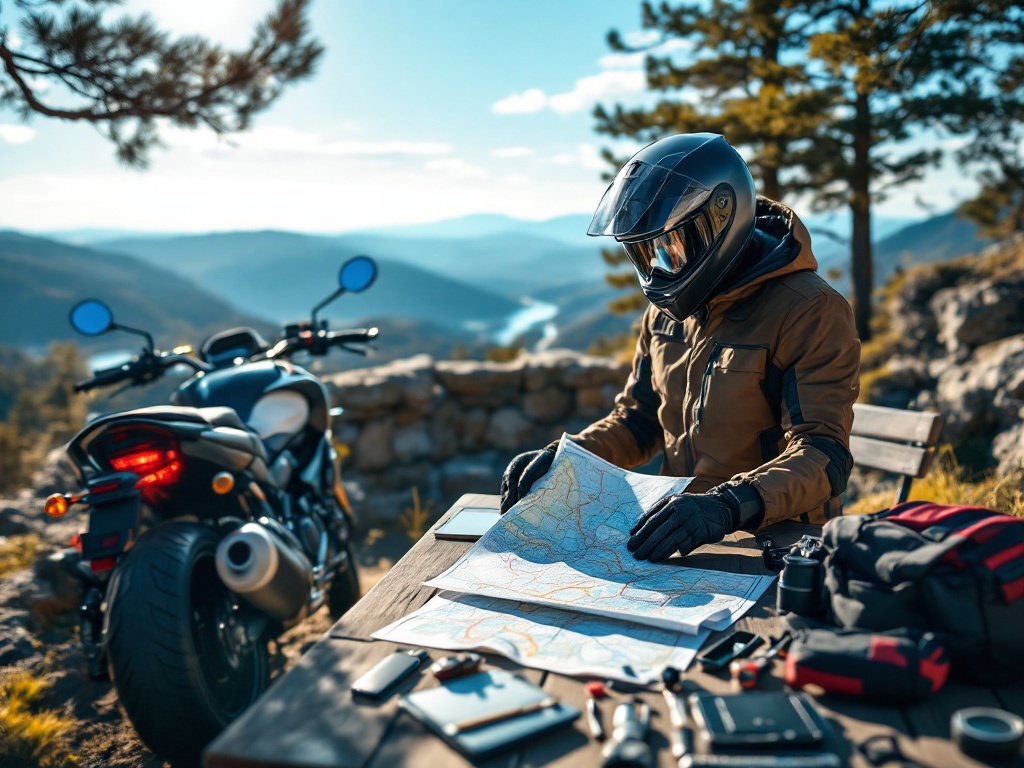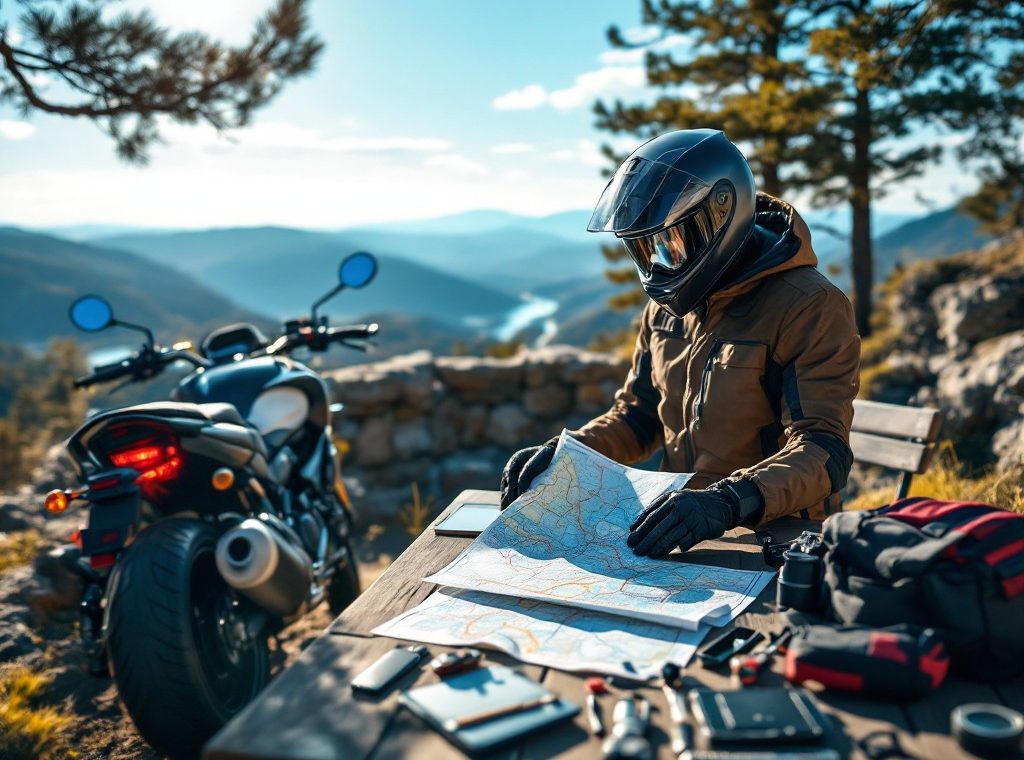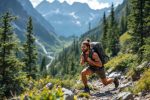How to Prepare for a Motorcycle Road Trip? Essential Tips and Checklist
Ready for the open road? Planning a motorcycle adventure is exciting, but proper preparation is key for a safe and enjoyable trip. This guide covers everything from essential motorcycle maintenance and route planning to packing the right gear and staying hydrated. Learn how to handle unexpected situations, adapt to changing weather, and prioritize your safety on the road. Start your journey prepared and informed – read on to make your next motorcycle road trip your best yet.
Important information

- Thorough motorcycle maintenance is crucial before embarking on a road trip. Check tires, brakes, fluids, and lights.
- Plan your route meticulously, including fuel stops, potential hazards, and alternate routes. Share this plan with someone you trust.
- Pack essential riding gear (helmet, jacket, gloves, boots) and items for emergencies (first-aid kit, tools, rain gear).
- Stay hydrated, take regular breaks, and avoid distractions to maintain focus and prevent fatigue.
- Prepare for varied weather conditions by packing layers and checking forecasts. Have contingency plans for unexpected situations.
Motorcycle Road Trip Preparation
Preparing for a motorcycle adventure requires careful planning and attention to detail. Ensure your motorcycle is in top condition by performing necessary maintenance checks and repairs. A reliable machine is crucial for a smooth and safe journey. Meticulously plan your route, considering factors such as fuel stops, road conditions, and potential detours. Packing the right gear is essential for handling unexpected situations. Include rain gear for sudden downpours, a basic tool kit for minor mechanical issues, and a first-aid kit for emergencies. Anticipate potential challenges, such as inclement weather or traffic delays, and have contingency plans in place. Thorough preparation ensures a more enjoyable and worry-free motorcycle adventure.
Motorcycle Maintenance. Ensure your bike is in peak condition with a thorough check-up, including tire pressure, brakes, fluids, and lights.
Route Planning. Map your route meticulously, identifying fuel stops, potential hazards, and alternative routes.
Essential Gear. Pack appropriate riding gear, including a helmet, jacket, gloves, and boots, as well as rain gear and a basic tool kit.
Contingency Planning. Prepare for unexpected situations, such as inclement weather or mechanical issues, by having backup plans and emergency contacts.
Essential Planning and Preparation Tips
Map your route and choose your destinations.
Craft a realistic itinerary, including planned stops and rest breaks.
Secure accommodations in advance, particularly if traveling during peak season.
Share your itinerary with a trusted friend or family member.
Pack essential gear like a first-aid kit, navigation tools, and rain gear.
Prepare your motorcycle with a thorough inspection and maintenance check.
Researching Weather Conditions
Before heading out, consult the weather forecast and pay attention to the temperature, precipitation, and wind speed along your planned route. Keep in mind that mountains and valleys create their own microclimates, so elevation changes significantly impact conditions. Pack accordingly for a range of weather possibilities, and be prepared to adjust your plans as unpredictable weather can quickly change.
Scheduling Regular Breaks
Regular breaks are essential for a safe motorcycle trip. Stopping every two to three hours helps combat rider fatigue and stiffness, which in turn boosts alertness and road safety. Use these breaks to stretch, walk around, and hydrate – it truly makes a difference.
Ensuring Hydration
Staying hydrated is crucial for safe motorcycling. Dehydration impairs your reaction time and judgment, a dangerous combination on a bike. Carry water bottles or consider a hydration pack. Sip regularly, even before you feel thirsty. Electrolyte drinks or tablets can replenish vital minerals lost through sweat and further enhance hydration. Stay hydrated for a safer and more enjoyable ride.
Motorcycle Pre-Ride Checklist
Gear up with a helmet, gloves, protective jacket, and sturdy boots.
Ensure your tires have the correct pressure and sufficient tread.
Inspect brake pads and fluid levels for optimal performance.
Confirm all lights, signals, and mirrors are functioning correctly.
Pack essential tools and a first-aid kit for emergencies.
Secure your luggage to maintain stable handling.
A GPS or communication device can enhance your trip.
Now, enjoy the ride!
Motorcycle Maintenance and Tool Kit
A motorcycle tool kit is essential for any road trip, enabling you to handle minor repairs and maintenance on the go. Pack wrenches, screwdrivers, and Allen keys for adjustments and fixes. A tire pressure gauge and puncture repair kit are also crucial for addressing tire issues, ensuring a smooth and trouble-free journey.
Rider Health and Safety
Before embarking on a long motorcycle journey, prioritize your physical and mental well-being. Consult a doctor if you have any health concerns. Adequate rest is essential for a safe and enjoyable trip.
Packing List for a Motorcycle Road Trip
Riding gear is essential for a safe and enjoyable motorcycle trip. Consider these points:
Protection
- Helmet.
- Armored jacket.
- Riding pants.
- Gloves.
- Boots.
Comfort
- Rain gear.
- Layers for changing weather.
- Neck warmer or cooling vest.
Pack personal items like underwear, socks, shirts, and comfortable pants for when you’re off your bike. A light jacket or fleece is ideal for cooler evenings. Don’t forget sun protection: sunscreen, sunglasses, and a hat.
Optimize your motorcycle’s storage with saddlebags, a tank bag, or a tail bag. Use waterproof bags or dry bags to protect your belongings. Secure everything with bungee cords or a cargo net.
Navigation & Electronics
- GPS device or smartphone with navigation apps.
- Charger.
- Power bank.
- Headphones.
- Camera.
Toiletries & Health
- Travel-sized toothbrush, toothpaste, soap, shampoo, and deodorant.
- Hand sanitizer.
- Wet wipes.
- Insect repellent.
Pack food and water: energy bars, nuts, dried fruit, and other snacks. Stay hydrated with a hydration pack or water bottle. A water filter or purification tablets might be needed depending on your destination.
Essential documents: motorcycle license, registration, insurance, a copy of your passport or ID, and medical information.
A basic tool kit with a tire repair kit, zip ties, and duct tape can be invaluable for minor repairs and emergencies.
Motorcycle Clothing and Gear
Motorcycle safety and comfort depend on proper gear. A DOT-approved helmet is crucial for head protection. Riding jackets and pants provide essential abrasion and impact protection. Gloves protect your hands and improve grip, while sturdy boots shield your feet and ankles. Always consider the weather and dress accordingly. Thermal undergarments offer warmth in cold conditions, while cooling vests help combat heat. Eye protection is vital, and earplugs combined with a neck tube can significantly enhance comfort by reducing wind noise and protecting against the elements. Choose gear made from abrasion-resistant and weatherproof materials for maximum protection and riding enjoyment.
Personal Clothing and Essentials
Pack smart for your ride by layering clothing adaptable to changing weather. Start with base layers for foundational comfort, add casual wear for versatility, and include thermal undergarments for warmth when needed. For personal care, pack toiletries, sunscreen, and lip balm to shield yourself from the sun. A first-aid kit is essential for addressing minor injuries on the go. Don’t forget a travel towel and toilet paper for convenience. Lastly, ensure you have your ID, necessary medications, and a portable charger to keep your devices powered throughout your journey.
Luggage and Storage Solutions
Roll your clothes instead of folding them to maximize luggage space. Pack heavier items at the bottom of your luggage for stability. Utilize shoes as extra storage for small things like socks and toiletries.
Organizing your belongings in separate bags or compartments keeps everything tidy and ensures you have room for souvenirs.
For camping, prioritize light and compact backpacking gear. A small packing or bikepacking tent, combined with an inflatable or traditional sleeping pad, is ideal.
Waterproof your food and gear with dry bags, which also aid organization. A minimalist camp kitchen, perhaps a single pot and utensil set supplemented with multi-use tools, saves both space and weight.
Electronics and Navigation Devices
Technology enhances motorcycle road trips. GPS units or smartphone navigation apps provide real-time directions and traffic updates, minimizing delays. Bluetooth headsets allow for communication between riders. Portable chargers and power banks ensure these devices remain operational throughout the journey. These tools help riders stay connected and informed on the road.
Hygiene Items and Toiletries
When preparing for your trip, remember your essential toiletries: toothbrush, toothpaste, shampoo, soap, deodorant, sunscreen, and insect repellent. A compact first-aid kit with bandages, antiseptic wipes, and pain relievers is also a must-have.
Food, Water, and Hydration Systems
- Pack non-perishable foods like energy bars, nuts, and dried fruit.
- Hydration is essential, so bring a hydration pack or reusable water bottles.
- Remember a water filter or purification tablets to replenish your supply.
Paperwork and Important Documents
Ensure your motorcycle registration, insurance, and license are up-to-date.
Carry both paper and digital copies of your documents.
Prepare a readily available emergency contact list.
For international trips, ensure you have a valid passport and any necessary visas.
Obtain an international driving permit for driving overseas.
Carry medical cards with allergy and blood type information for emergencies.
Tools and Maintenance Equipment
A robust roadside repair kit is essential for any unforeseen circumstances. Pack the following items:
- tire repair kit,
- wrenches,
- screwdrivers,
- Allen keys,
- zip ties,
- duct tape,
- portable air compressor or CO2 cartridges.
Riding Tips for a Long-Distance Motorcycle Trip
Choose the Right Gear
Select a motorcycle appropriate for your journey’s length and terrain. Invest in a well-fitting helmet, riding jacket, and pants with protective armor. Gloves and durable boots are also essential for safety and comfort.
Prioritize Comfort
Comfort is key to preventing fatigue. Adjust your posture, take regular breaks, and consider accessories like backrests and highway pegs. Proper hydration and nutrition also play a vital role in staying alert and energized.
Maintain Focus
Maintaining focus is paramount for safe riding. Avoid distractions such as mobile phones and be acutely aware of your surroundings. Regular breaks help maintain alertness and prevent fatigue.
Prepare for Changing Weather
Be prepared for changing weather conditions by packing layers of clothing. Carry rain gear and be ready for potential hazards like fog or strong winds. Thorough preparation ensures a safe and enjoyable ride.
Choosing the Right Motorcycle and Gear
Choosing the right motorcycle depends on your riding style and needs.
Cruisers
Ideal for long-distance rides, cruisers prioritize comfort and style, offering a relaxed riding position and ample power for highway cruising.
Sportbikes
Built for speed and agility, sportbikes deliver exhilarating performance with responsive handling and powerful engines, perfect for adrenaline-pumping rides.
Touring
If you value comfort and storage, touring motorcycles are equipped with weather protection, luggage space, and features designed for extended journeys.
Adventure/Dual-Sport
For riders who crave versatility, adventure and dual-sport bikes excel on both paved and unpaved roads, offering ruggedness and adaptability for exploring diverse terrains.
Prioritize safety by investing in essential gear:
- a well-fitting helmet,
- riding jacket,
- gloves,
- boots, and
- riding pants.
Staying Comfortable and Preventing Fatigue
Combat rider stiffness and fatigue with these tips:
Movement and Positioning
- regularly adjust your riding position,
- shift your weight on the seat,
- use highway pegs (if available),
- stand up occasionally when safe.
Hydration
Staying hydrated is crucial. Regular water breaks prevent dehydration and its associated drowsiness and muscle cramps.
Proper Gear
- Choose moisture-wicking base layers,
- select weather-appropriate outerwear to regulate body temperature,
- wear comfortable, well-fitting gloves and boots.
Rest Stops
Take frequent breaks every hour or two. Stop to stretch, walk around, and refocus. Prioritize safety when choosing your rest stops.
Maintaining Focus and Reaction Time
Staying hydrated is essential for sharp focus and quick reactions. Dehydration can slow down both your mind and body. Regular breaks are also crucial for combating fatigue and boosting alertness. So, drink plenty of water and take short breaks to stay sharp.
Adapting to Weather Changes and Conditions
Consider the weather forecast when packing your motorcycle gear. Pack breathable fabrics and lighter gloves for summer rides. For colder weather, pack warm, waterproof layers, and consider heated gear for maximum comfort.
Choose a full-face helmet for crucial protection and ventilation.
Layer your clothing to adapt to fluctuating temperatures.
Invest in a quality riding jacket and durable boots for both comfort and safety on the road.
Plan for detours, as unexpected weather or road closures can occur. Having backup routes ensures a smooth journey and may lead to exciting discoveries.
Prioritizing Rider Safety
Prioritize safety by equipping yourself with proper gear, including a helmet, jacket, gloves, and boots.
Stay hydrated by drinking plenty of water, particularly in hot weather.
Take regular breaks to combat fatigue and sharpen focus.
Adhere to traffic laws and practice defensive riding techniques.
Carry a first-aid kit and familiarize yourself with basic procedures for handling minor injuries.
Perform regular motorcycle maintenance and inspect your bike before and during the trip to ensure roadworthiness.
Carry a basic tool kit for minor repairs like tightening bolts or adjusting mirrors, but leave major issues to professionals.
















